June 2022 Executive Summary for the 6th Report of the Federal Monitor, Covering the Period from October 2021 through March 2022
Federal Monitor
Case 3:12-cv-02039-FAB Document 2067-2 Filed 06/15/22
This is the sixth Chief Monitor’s Report (CMR-6) outlining the compliance levels of the Puerto Rico Police Bureau (PRPB) in relation to the Consent Decree entered between the United States and the Commonwealth of Puerto Rico. This report provides the sixth assessment following the four-year capacity building period established by the Consent Decree that ran from June 2014 to October 2018 and covers the period from October 2021 through March 2022.
Overall, the compliance assessment in this report demonstrates stalled progress. Although PRPB has improved in the development of its policies and procedures, as was the case in CMR-5, significant progress needs to be made in the training and practical application of these policies and procedures, see figure one. Further, when examining the total paragraphs assessed in this report (N=179) in comparison to the previous report in which these sections and paragraphs were assessed (CMR-4; N=178), the Monitor notes PRPB’s progress has remained relatively the same during this reporting period. For example, 66 paragraphs met partial compliance and 63 paragraphs were rated not compliant during this reporting period, in comparison to 63 paragraphs rated as partially compliant and 83 as not complaint in CMR-4. Further, when reviewed comprehensively, over 50 percent (N=93) of the paragraphs meet either partial or substantial compliance in CMR-6 in comparison to 48 percent (N=86) in CMR-4.
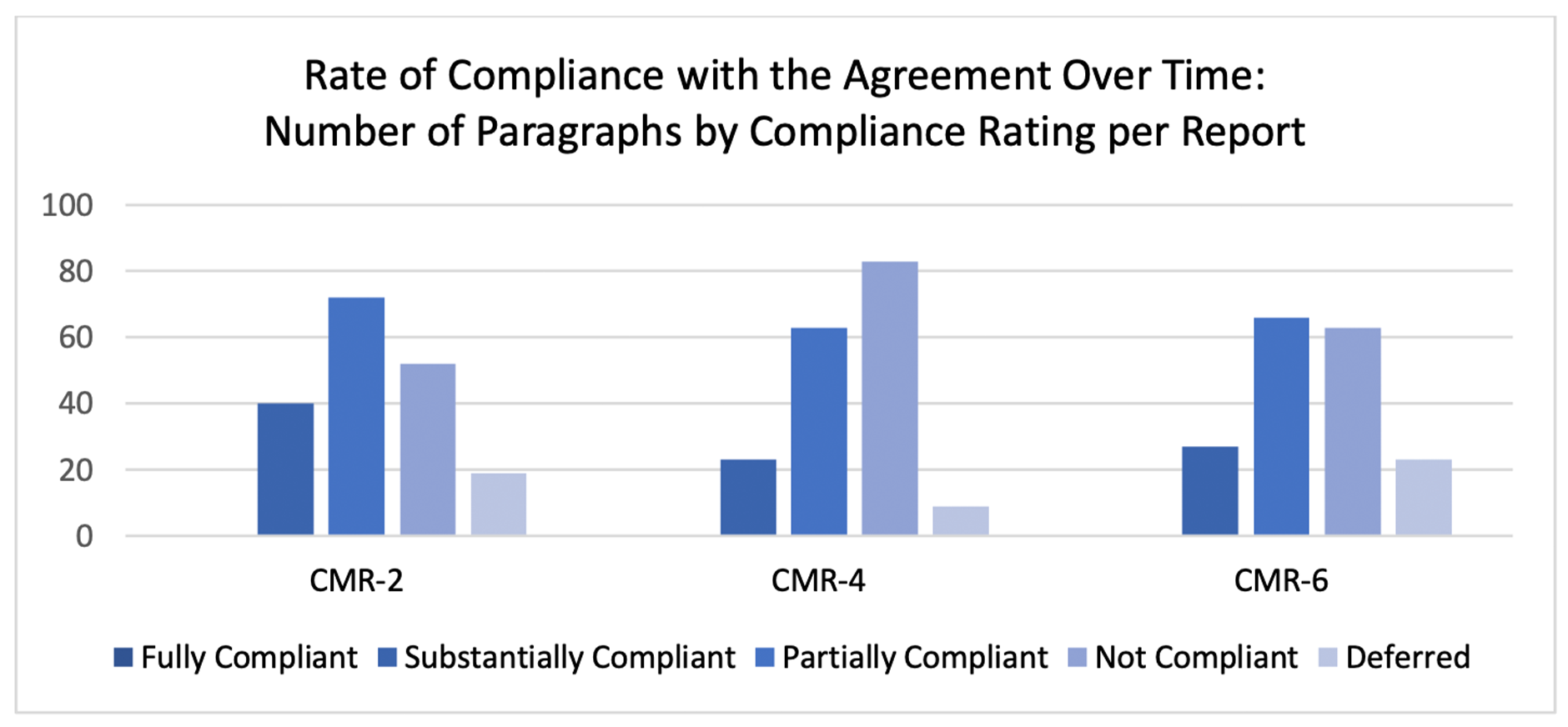
As noted by the Monitor in previous reports, additional work is needed to implement the requirements in all areas and paragraphs of the Agreement. During this reporting period, PRPB’s efforts towards partial and/or substantial compliance with many of the paragraphs remained at a standstill. The development and conduct of training on several of the revised policies and procedures continues to lag and be affected by the lack of a virtual training platform and COVID-19 related restrictions. Further, repeated issues like poor documentation of probable cause and the use of boiler plate language on arrest reports, failures in supervision to issue corrective actions, and exceeding timelines in Force Investigation Unit (FIU) investigations and Commissioner’s Force Review Board (CFRB) evaluation of uses of force (UOFs) are just a few examples of issues continuously raised by the Monitor in his reports.
Despite these challenges, the Monitor is encouraged by PRPB’s progress with some paragraphs, particularly in the areas of Internal Audits, the Field Training Officers (FTO) program, and the Reform Unit’s efforts on the expansion of community policing technical assistance in the various PRPB Area Commands across the island. The efforts made by PRPB, particularly in the FTO program and community policing technical assistance across the Bureau represent areas in which PRPB is excelling and inline with best policing practices.
Monitoring Activities During CMR-6
Over the past six months the Monitor and his team conducted six field visits to PRPB’s headquarters as well as various regions of the island. These field visits provided an opportunity for the Monitoring Team to hear directly from supervisors and officers on the front line, speak with members of the Puerto Rican community, observe operations, receive system demonstrations, and validate the assessments they made as part of their review of the nearly four thousand policies, documents, certifications, audio recordings, and case files and reports provided for review during the CMR-6 reporting period. The Monitoring Team also reviewed over 100 policies, PPRs, and protocols under paragraph 229 of the Agreement, observed various PRPB community engagement efforts, and observed training sessions conducted by SAEA and/or the Reform Unit during this reporting period.
In addition, during this reporting period, the Monitor and his team participated in two status conferences. After the appointment of Honorable Gustavo A. Gelpi to the U.S. Court of Appeals for the First Circuit, the case was transferred to Honorable Francisco A. Besosa, Senior U.S. District Judge, on October 18, 2021. The status conferences held in January and March of 2022 renewed focus on the issues stalling progress in PRPB’s reform, specifically in the areas Information Systems and Technology, UOF, and Supervision and Management. The district court made clear that the responsibility for reform of PRPB does not fall squarely on the Bureau but also rests on the shoulders of the broader Puerto Rican government and its leaders. Court orders for PRPB to work with the Monitor, the U.S. Department of Justice (USDOJ), and the Special Master on the development of plans for UOF, supervision, and IT subsequently followed these status conferences. In the following months, the Monitor and his team worked closely with the parties to develop the plans to address the issues discussed in the status conferences. As the reporting period ended, a joint stipulation on IT, an Agreement in Principle on Supervision, and a provisional plan to address the inconsistencies in UOF reporting were filed with the Court.
Overview of Status of Compliance
The following summary provides an overview of the Monitor’s compliance assessment for each area of the Agreement.
1. Use of Force
PRPB has repeatedly been unable to validate its UOF numbers. For the CMR-6 reporting period, PRPB continued to lack a mechanism to validate its reporting of UOF incidents, and the number of UOFs in those incidents. To address this issue PRPB revised its form PPR-126.2 (Complaint Card) to include additional fields that would capture the number and levels of force used by officers. PRPB also developed a Use of Force Dashboard to display the number of UOF incidents in real time.
In addition to the changes to the 126.2 form, PRPB began requiring that all forms related to UOF reporting (PPR-605.1) and investigations (PPR-605.3) be completed in the Global Technology Enterprise (GTE) System, thereby eliminating any handwritten paper copies of these reports. Although PRPB made efforts to address the inaccuracies in UOF reporting with the changes to PPR-126.2, the Monitor found that these changes further highlighted the procedural issues in the entire UOF reporting process and brought to light the inconsistences between the information documented in the initial complaint card (PPR-126.2), the officer’s UOF report (PPR-605.1), and the Supervisor’s UOF Investigation (PPR-605.3). In addition, in some instances, the Monitor also found that personnel were not completing these reports in GTE and continuing to use paper copies and/or were not completing these reports in a timely manner, as required by policy.
In January 2022, the Court held a status conference where the issues related to UOF, supervision, and IT were brought forth by the Monitor. As a result, the Court ordered PRPB to work with the USDOJ, and the Monitor to develop a plan to address the inconsistencies in the UOF data. Over the proceeding months, the Parties and the Monitor worked together to develop a provisional plan to address the issues with the UOF data and noted that in the long term these issues would be assessed as part of the IT needs assessment. 1 PRPB filed a Provisional Plan for UOF Data with the Court on April 13, 2022. The Provisional Plan establishes a revised process for validating information captured in the related UOF forms, increased accountability, and if implemented successfully, increased validity in the UOF reporting process.
Although the inconsistencies in the UOF data largely affect many of the paragraphs in this section, other topics such as FIU, Force Review Boards (FRBs), Crisis Intervention Training (CIT), SWAT, and crowd control procedures also affect PRPB’s overall compliance with this section. As it relates to FIU, the Monitor’s Office continues to remain concerned regarding the amount of time FIU is taking to complete its investigations. In almost all cases reviewed, the investigations were not completed within the 45-day requirement. Similarly, in the Monitor’s review of CFRB evaluations, while the evaluations were objective, they also were not timely.
CIT, as like UOF, was also discussed during the January 14, 2022, status conference. As PRPB expands its CIT program it should use the feedback and analysis of the pilot program conducted in Arecibo in 2019 to inform its approach and implementation of CIT in the other areas of the island. In response to the January 14, 2022, status conference, the Court ordered PRPB to establish an evaluation committee tasked with conducting an evaluation of the CIT pilot in Arecibo. Since this time, PRPB has worked with USDOJ and the Monitor to establish this committee and identify potential evaluation methods and performance measures to gauge the impact of this program and inform the implementation of CIT Bureau-wide.
Overall, PRPB’s compliance with the 36 paragraphs assessed during this reporting period within Use of Force section reflect similar levels of compliance to what was noted in previous reports. In CMR-5, 53% of paragraphs (19 paragraphs) were assessed as partially compliant and 8% (3 paragraphs) were assessed as substantially compliant, in comparison to the current reporting period, where 53% of paragraphs (19 paragraphs) were found to be partially compliant and 17% (5 paragraphs) were found to be substantially compliant. The increased number of paragraphs in substantial compliance directly relates to the improved training, operations, and documentation of STU units. Six of the thirty-six paragraphs were also noted as deferred in CMR-6, as a result of the inconsistencies in UOF reporting. See figure 2.
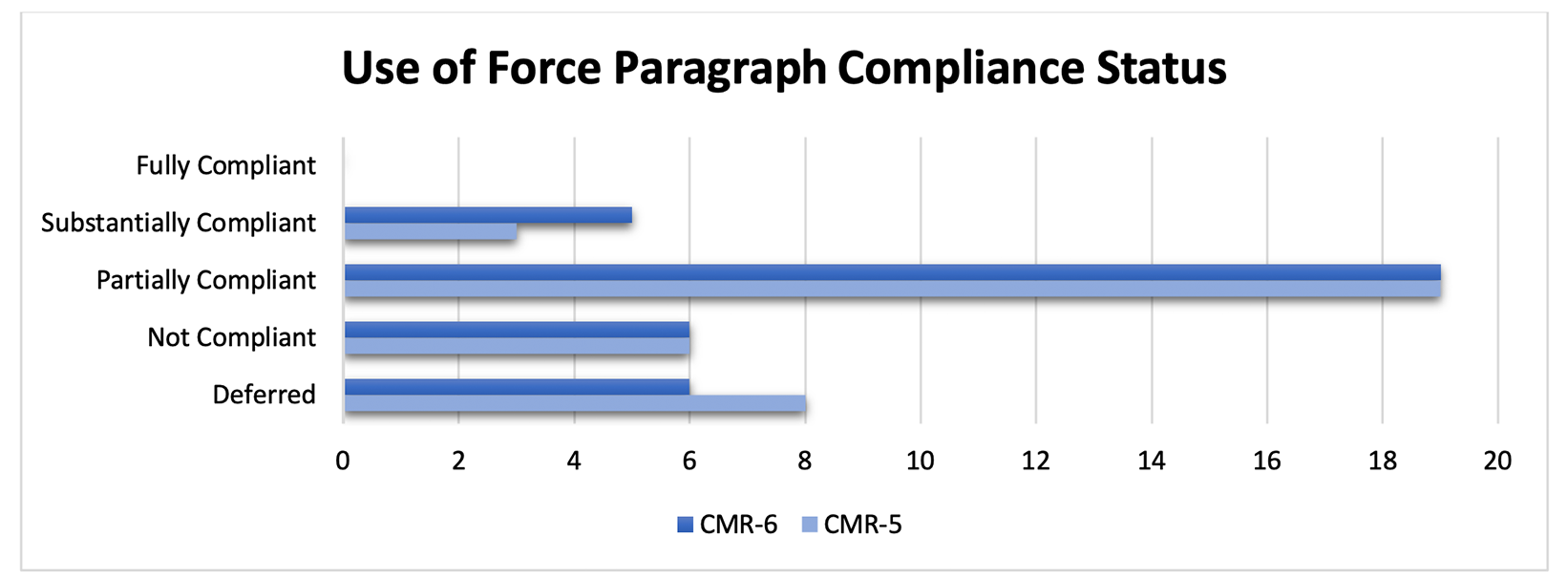
2. Searches and Seizures
PRPB provided the Monitor’s Office with spreadsheets containing data on 9,159 arrests and 684 searches conducted during the CMR-6 reporting period. The Monitor’s Office used random decimal generation in excel to randomize the order of this data to draw a random sample of 94 arrests and 67 searches. 2 The Monitor reviewed and analyzed 94 randomly selected arrest files and 67 search warrant files, including 3 arrests conducted by Municipal Police Departments. The Monitor, as in the past, rated a high number of arrest files as partially compliant or not compliant due to missing required PPR forms and lack of appropriate documentation of probable cause. In review of the search and seizure files, 41 were rated as partially or not compliant, also mostly due to the lack of required forms.
Further, the Highway Patrol Division continues to submit incomplete arrest files which lack proper probable cause documentation and include repetitive and boilerplate language.
Of the 29 consent searches reviewed, most were properly documented on PPR-612.1 (Consent Search), but a few were not documented (or forms were not submitted) and others lacked detailed information as required by the form.
All the above shortcomings have been outlined by the Monitor in prior reports but continue to persist. This continued ambivalence in addressing these issues is of concern to the Monitor. Progress with many of the paragraphs will continue to stall if these issues persist.
Overall, PRPB’s compliance with the 18 paragraphs assessed during this reporting period within Search and Seizures reflect a regression in levels of compliance to what was noted in previous reports. In CMR- 5 36% of paragraphs (8 paragraphs) were assessed as partially compliant, in comparison to the current reporting period, where 17% of paragraphs (3 paragraphs) assessed were found to be partially compliant. Due to the continued lack of improvement or actions of PRPB to address or begin to address these issues, the Monitor reverted several paragraphs to not compliant. See figure 3.
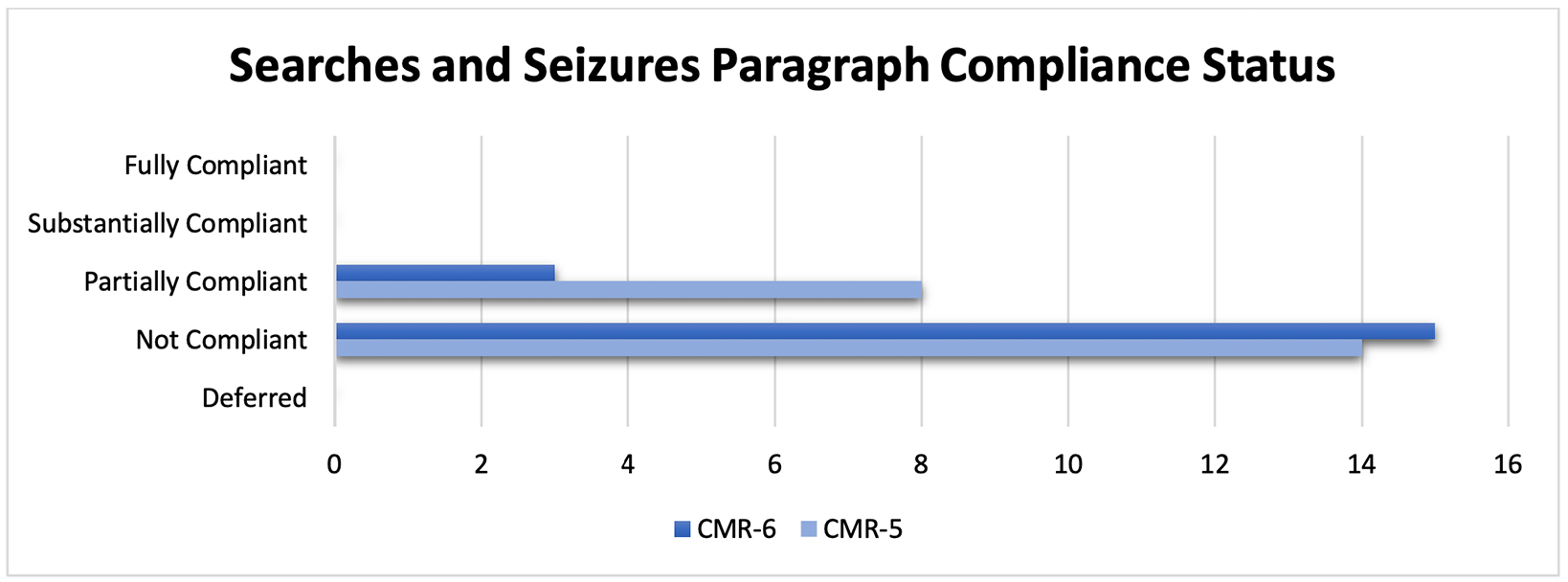
3. Equal Protection and Non-Discrimination
The Equal Protection and Non-Discrimination section reviews an array of cases specifically related to sexual assault, domestic violence, and related cases that entail any abusive behavior by one person to maintain power over another in a close relationship. Non-discrimination is also a compliance target in this section. PRPB must ensure through its policies and practices that it does not discriminate in any manner towards its own officers or the community members of Puerto Rico.
As noted in previous reports, much of PRPB’s progress in this area remains at partial or non-compliance. Of the 21 paragraphs within Equal Protection and Non-Discrimination, a limited number are assessed every six months. A comprehensive review of this entire section was provided in CMR-5 and will be provided again in CMR-7. For CMR-6, only 10 paragraphs (paragraphs 84 - 86, 88 - 90, 92 - 93, 96, and 99) are assessed in this report and, in most instances, only specific targets within these paragraphs are assessed biannually. The compliance targets assessed in this reporting period are bolded in the paragraphs listed above.
The paragraph compliance targets assessed in this reporting period primarily focus on PRPB’s efforts to demonstrate implementation of processes related to hiring, the civilian complaint system, performance evaluations, juvenile case management reporting, hate crime reporting, and bias-free policing training. There are no significant changes in PRPB’s progress in meeting the compliance targets assessed in this reporting period.
4. Recruitment, Selection, and Hiring
Police recruitment, selection, and retention are critical to the advancement of community policing and of the policing profession in general. However, recruitment and staffing shortfalls continue to plague law enforcement agencies across the United States. COVID-19 has also had a detrimental impact on PRPB’s recruiting efforts. Nevertheless, PRPB provided data that demonstrates a concerted effort both to recruit qualified candidates, and to vet them thoroughly.
The goal of police recruitment is and always has been to hire not merely enough people but the right people. Police executives’ notions of what constitutes the right people is changing. They are now more likely to seek to increase the diversity of their departments across the spectrums of race, ethnicity, gender, age, and sexual orientation.
Overall, PRPB has put a tremendous effort into addressing these challenges with a comprehensive recruitment plan and effective recruitment programs that solicit recruits from a broad cross-section of the Puerto Rican community. However, important gaps remain in the training of recruitment officers and the implementation of the recruitment plan in practice.
The Monitor finds that PRPB is in partial compliance with the Agreement regarding recruitment, selection, and hiring policies and procedures. PRPB has tried to recruit and hire qualified personnel and develop recruitment strategies that promote inclusive selection practices that better reflect a diverse cross-section of the Puerto Rican community. PRPB still needs to improve in certain areas as well as institutionalize many of these practices to achieve substantial compliance.
It should be noted that the Recruitment Division is working with INTERBORO in the development of a platform that will expedite the recruitment process. PRPB should also ensure that members of each area in Puerto Rico are trained in the use of the INTERBORO platform to help achieve PRPB’s goals in recruitment numbers. The INTERBORO system will make PRPB more effective and efficient in recruitment and automate valuable information and statistics.
Overall, PRPB’s compliance with the eight Recruitment, Selection, and Hiring paragraphs assessed during this reporting period reflect the same levels of compliance to what was noted in previous reports. In CMR-2, CMR-4, and CMR-6 all paragraphs were assessed as partially compliant. See figure 4.
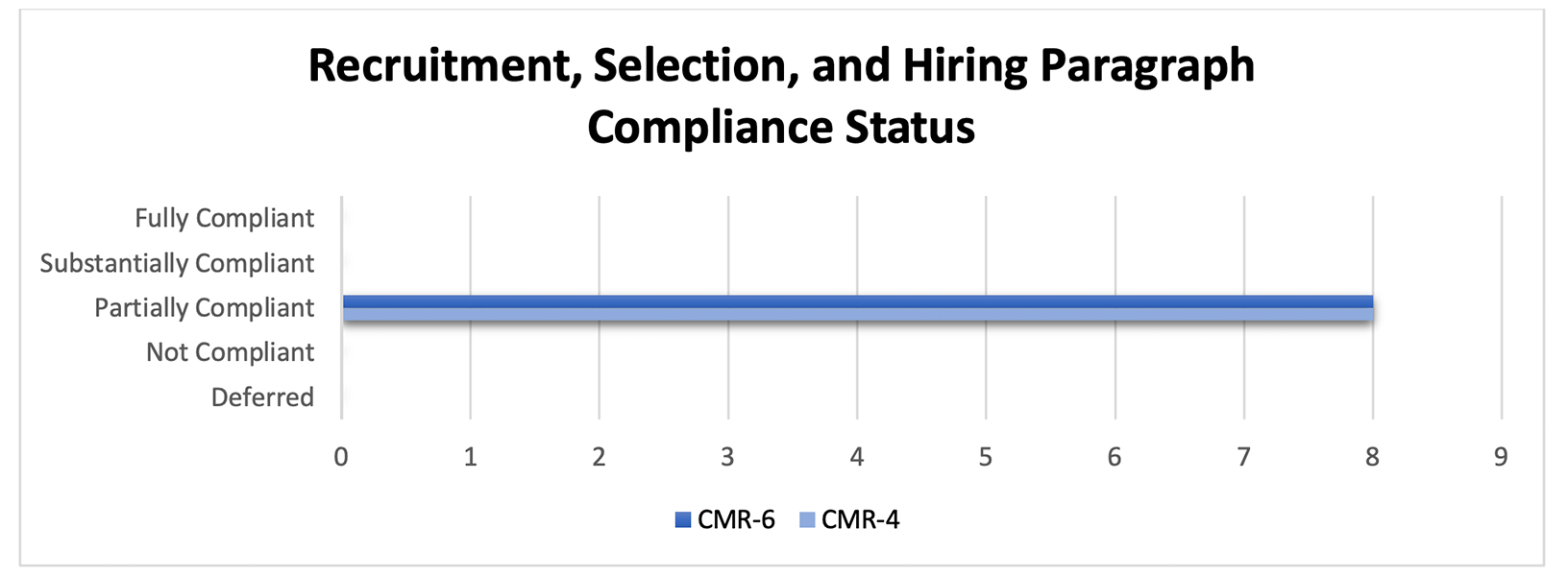
5. Training
The Training section of the Agreement is assessed annually and, in this report, covers the review period of April 2021 through March 2022. The Monitor’s assessment of PRPB’s compliance with training is based on the training documents submitted by PRPB, interviews with staff assigned to the Training Academy, Field Training Officers (FTOs), FTO Coordinators, and others involved in the development and conduct of academy, in-service, and FTO training.
Over the last year, PRPB has had to adjust its training delivery for several courses due to COVID-19 restrictions and compromises in the integrity of the virtual training system. As noted in previous reports and shown in other related areas of the Agreement, much work remains for PRPB to achieve preliminary compliance with several of the paragraphs within this section. Specifically, the sections of pre-service training, in-service training, and training record management still need work to attain compliance. Areas that need improvement are the provision of additional equipment to support training instructors in the delivery of scenario-based training and full use of the Police Training Management System (PTMS) to register, record, and evaluate training courses provided by PRPB.
Although the Monitor was able to meet with and interview various staff involved in the development and conduct of training, PRPB failed to submit the data and documentation necessary for the Monitor to assess this area in a comprehensive manner. Documentation such as projected training calendars/schedules and course curriculum files were not provided. Additionally, despite the Monitor’s several requests for training calendars and schedules, none were provided in advance of the conduct of these trainings, and the Monitor was limited to observing one FTO training course during one of the team’s site visits. Further, the Monitor has yet to receive any related course materials for review and evaluation, limiting our ability to assess the conduct of training in the Training Section as well many of the other areas of the Agreement.
Despite the challenges and issues noted above, PRPB has demonstrated progress in the conduct and delivery of its FTO program. The FTO training program is modeled after national best practices and PRPB has demonstrated progress in the development, delivery, and practice of all aspects of this training program.
Training, like policy, is a foundational pillar to the success of any police agency. Policing agencies must have the ability to provide services to the community in a safe and equitable manner and establish a culture of continual learning and reform. PRPB must prioritize its training efforts to advance its progress towards compliance. Training is woven in and across all areas of the Agreement and is the cornerstone to the Bureau’s progress from non-compliance to partial compliance. While PRPB recognizes that training is important, it must prioritize it’s training capacities.
Overall, PRPB’s compliance with the 18 Training paragraphs assessed during this reporting period reflect substantial improvement in levels of compliance compared to what was noted in previous reports. In CMR-4, 94% of paragraphs were assessed as not compliant, in comparison to the current reporting period, where 61% of paragraphs were found to be partially or substantially compliant; all other paragraphs are noted as not compliant. See figure 5.
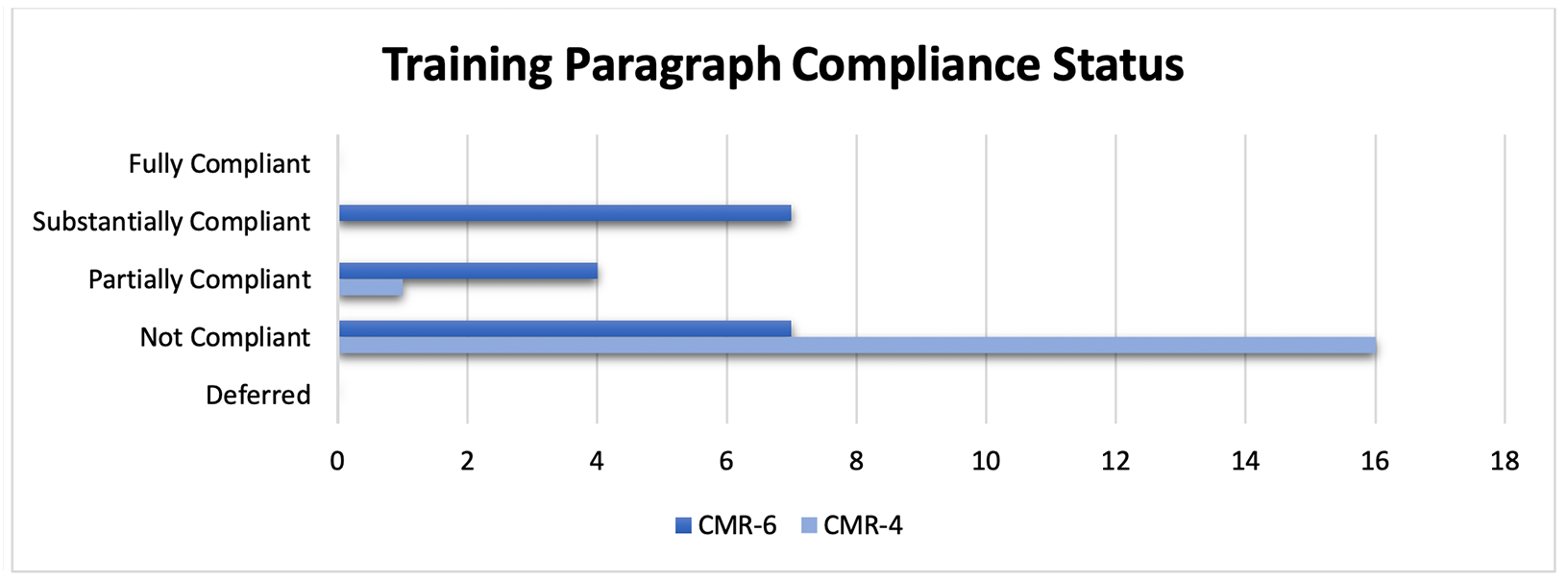
6. Supervision and Management
Supervision and Management is one of the most important areas of the Agreement, as supervision provides the link between PRPB leadership, and the officers engaged in law enforcement operations. Supervisors are essential for bringing PRPB in alignment with generally accepted policing practices throughout the Agreement. Supervisors serve as a two-way conduit of information between PRPB leadership and the rank and file, making it essential for supervisors to spend adequate time in the field with their supervisees to evaluate their performance.
Nevertheless, PRPB is still plagued by inadequacies in both the quantity and quality of supervision. In terms of sheer numbers, PRPB is struggling to deploy an adequate number of supervisors in the field. The Monitor has determined that PRPB has not successfully implemented its 2018 Staffing Plan 3 or maintained accurate records of its staffing allocations and needs.
The deficit of first-line supervisors makes it even more essential that current supervisors use effective supervision principles. In the CMR-6 reporting period, the Monitor determined that there are still gaps in how PRPB supervisors understand and apply management principles. More work is required to bring Bureau-wide supervision into alignment with PRPB’s policies, procedures, rules, administrative processes, management systems, generally accepted policing practices, and the Agreement. To note one example, managers continue to transfer officers under their supervision without adequate explanation, such as noting whether the transfer was motivated by disciplinary issues. This lack of communication about these processes results in internal procedural justice issues and can lead to diminished morale among officers.
Due to ongoing issues with supervision, the Federal Court has increased its attention to this area at recent status conferences. In response, PRPB began developing a proposal to implement the 2018 Staffing Plan and worked with the Monitor’s Office and USDOJ to submit an Agreement in Principle regarding PRPB’s efforts to address the ongoing issues with supervision.
Overall, PRPB’s compliance with the 24 Supervision and Management paragraphs assessed during this reporting period reflect similar levels of compliance to what was noted in previous reports. In CMR-5, 21% of the 19 paragraphs (4 paragraphs) were assessed as partially compliant, in comparison to the current reporting period, where 29% of the 24 paragraphs (7 paragraphs) were found to be partially compliant. See figure 6.
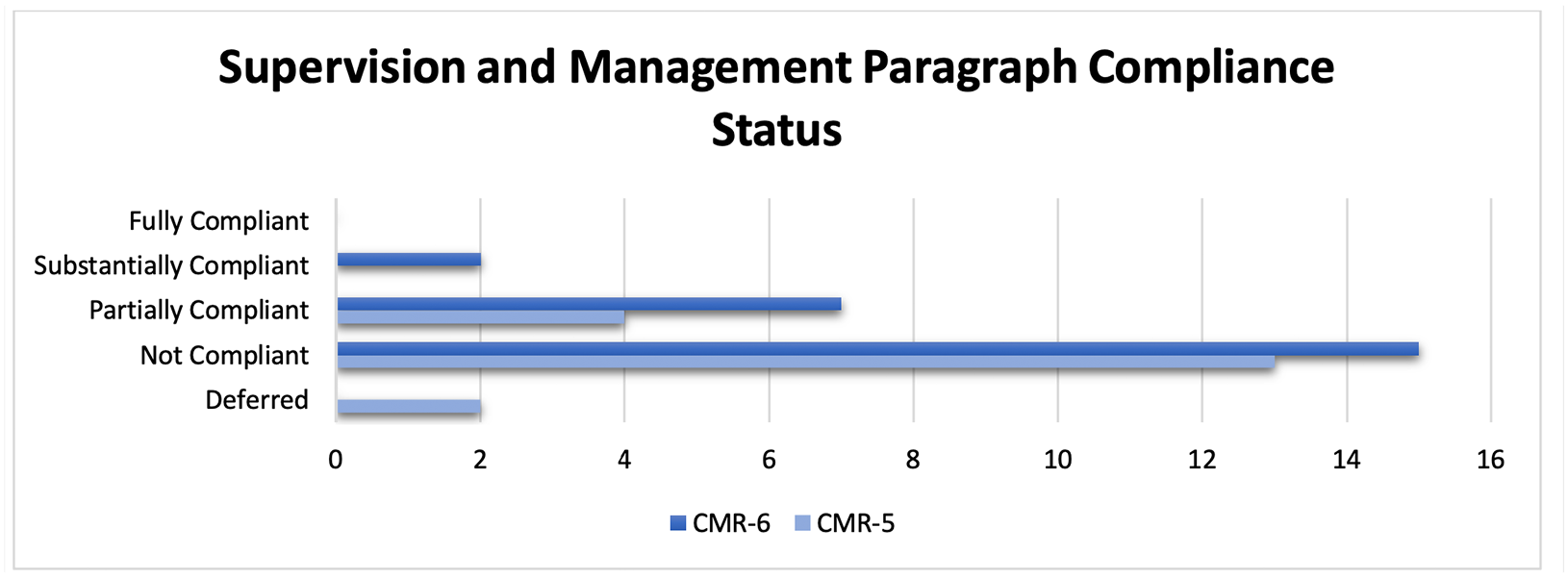
7. Civilian Complaints, Internal Investigations, and Discipline
To determine compliance with the paragraphs of this section, the Monitor reviewed 78 internal investigative files, civil lawsuits involving PRPB personnel, and interviewed over two dozen Auxiliary Superintendency of Professional Responsibility (SARP) investigators from each subunit within internal investigations. PRPB also supplied documentation on most related areas in a timely manner in response to the Monitor’s requests.
While most SARP investigator interviews indicated a persistent lack of resources and training, the Monitor is aware of formal written requests made by the SARP commander to help address these needs. To achieve substantial compliance with the Agreement, PRPB must align resources with the needs of this critical unit. The Monitor will closely follow developments in the procurement and delivery of requested training, equipment, and manpower.
In CMR-6, the Monitor requested only SARP investigations closed 4 during the reporting period. On one hand, this provided the Monitor a wider cross-section of criminal and administrative cases from which to base his findings upon. On the other hand, most of the underlying investigations were conducted well outside of the reporting period. In past reports, the Monitor has pointed out issues with the way that SARP interviews are conducted, recorded, and certified. Due to the age of the investigative files reviewed in this reporting period, it was not possible to fairly determine whether PRPB had modified some of these practices over the course of the CMR-6 reporting period. 5
At least internally, PRPB has made efforts to inform citizens of the Commonwealth of their right to address the perceived failings of PRPB officers by filing a complaint in person or digitally either as a named person or anonymously. Judging by the volume of complaints received and the diverse manners in which they were forwarded to SARP, the Monitor remains convinced that little or no actual impediment exists for a citizen to make such a complaint. From the perspective of a community member, however, the Monitor notes that PRPB could improve in advising citizens at open community meetings as to how to file a complaint or a commendation and explain in layperson’s terms how the internal investigative system works. Overall, the Monitor believes that the breadth and diversity of the complaints received supplies ample proof that the system is working; however, PRPB should continue its community outreach to ensure that civilians understand the process.
In the latest examination of case files, the Monitor has seen several examples of employees involved in more than one allegation of misconduct over the course of relatively short time periods. In viewing the complaint histories of said employees, there is abundant evidence of prior accusations of misconduct of a remarkably similar nature, which often pre-date the Agreement. What is lacking; however, are records indicating findings and outcomes of these investigations. The Monitor uses this to illustrate the importance of having an effective employee intervention system and proactively using it to help correct or assist these problem employees before, yet another similar incident is alleged.
Overall, PRPB’s compliance with the 46 paragraphs assessed during this reporting period within Civilian Complaints, Internal Investigations, and Discipline reflect a regression in compliance to what was noted in previous reports. In CMR-5, 46% of paragraphs (21 paragraphs) were assessed as partially compliant and 43% (20 paragraphs) were assessed as substantially compliant, in comparison to the current reporting period, where 28% of paragraphs (13 paragraphs) were found to be partially compliant and 28% (13 paragraphs) were found to be substantially compliant. Much of the regression in this area is due to issues in the provision of training for newly assigned SARP investigators. Seventeen of the forty- six (37%) paragraphs were also noted as Deferred in CMR-6. See figure 8.

8. Community Engagement and Public Information
During this reporting period, PRPB has continued training on the community policing philosophy through the Reform Unit. The Monitor found that 1 out of the 13 police areas (8%) has fully completed the three training cycles for this program. Additionally, 12 out of the 13 police areas (92%) have completed their first training cycle (Cycle I), while 6 police areas (46%) have completed their second training cycle (Cycle II). Because this training is being conducted by the Reform Unit, it is unclear to the Monitor how this training, while reflective of generally accepted police practices in community policing training, relates to the Academy’s efforts to conduct training on community policing Bureau-wide. It is also unclear to the Monitor how many PRPB personnel have received the Reform Unit’s training. Further, it was apparent to the Monitor that while PRPB has made efforts to revise its related policy (GO 805), revisions to the training curricula and the conduct of training remain stagnant.
PRPB also demonstrated improvement in community outreach though incremental during this reporting period. However, the Monitor notes that additional outreach efforts must be purposefully geared towards education and prevention and must employ multiple educational resources including audio- visual materials to reach broader community sectors. Meaningful outreach endeavors under the Auxiliary Superintendency of Crime Investigations (SAIC) for the police areas of Guayama, Fajardo, Mayaguez, Utuado, San Juan, and Ponce were conducted during this reporting period and can serve as examples of successful outreach efforts for other areas and units. The SAIC outreach efforts in these areas focused on gender-based violence, legal aspects of domestic violence, female self-defense, domestic violence during courtship, and safety within the home. The Monitor’s Office further notes that PRPB must expand its outreach efforts by proactively demonstrating its ability to address LGBTQIA+ concerns and recent crime trends to engage stakeholders in prevention and education efforts. PRPB must also work towards further developing and implementing its Community Engagement Module to efficiently document such initiatives and measure their effectiveness.
As in CMR 5, the Monitor reports that the institutionalization of community policing must begin with PRPB’s recruitment practices to ensure securing a diverse workforce - one that embodies the values and characteristics of community policing. Full implementation of community policing must take place through redeployment of personnel, including personnel in specialized units, to ensure that core PRPB operations support community policing and problem-solving strategies. This should be done in partnership with external agencies, community advocates, and stakeholders for more effective crime prevention. These practices should also be captured in PRPB’s personnel evaluation system, which is currently under evaluation by PRPB to solidify processes.
The Monitor confirmed that Community Interaction Councils (CICs), volunteer-based groups of the community which represent the 13 police areas, continue to experience challenges in securing full community representation as required in the Agreement and PRPB policy. Currently there are only three police areas that have obtained full community cross section representation. Two areas are missing two community members, while the remaining eight are missing five to nine representatives. This is concerning to the Monitor’s Office because the CICs advise, review, and offer recommendations to PRPB on policies, recruitment, and the implementation of strategies, including advising the Commissioner on ways to make information readily available to the public and increase transparency.
PRPB made progress in CMR-6 by expanding its use of social media and other platforms to keep the public informed. It shared gender inclusive workforce and leadership milestones with the public, which should be replicated moving forward. However, providing information to the public in a meaningful, engaging, transparent, and understandable way is fundamental for PRPB to develop the community’s trust and demonstrate accountability. This includes keeping the community abreast of PRPB’s directives and new policies, as well as providing straightforward statistics on crimes, including hate crimes and domestic violence, monthly as required by the Agreement. These objectives remain among the Monitor’s longstanding concerns, as noted in previous reports. Finally, PRPB must work on its technological deficiencies to keep the public informed of its community-oriented policing initiatives, new policies, and progress towards a sustainable reform. PRPB has yet to comply with most of these requirements.
Overall, PRPB’s compliance with the 13 Community Engagement and Public Information paragraphs assessed during this reporting period reflect similar levels of compliance to what was noted in previous reports. In CMR-5, 38% of paragraphs (5 paragraphs) were assessed as partially compliant, in comparison to the current reporting period, where 46% of paragraphs (6 paragraphs) were found to be partially compliant; all other paragraphs are noted as not compliant. See figure 8.
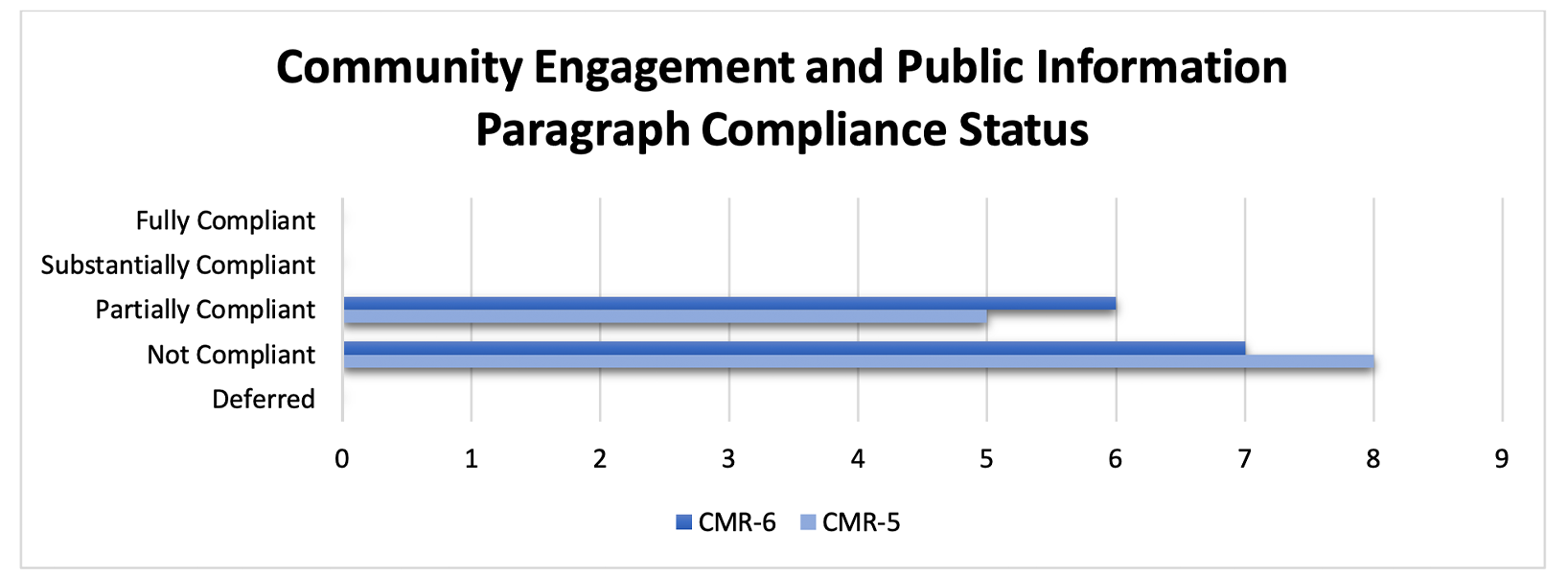
9. Information Technology
During the CMR-6 reporting period PRPB neither made nor lost ground regarding implementing its IT solutions. This status bore itself out during the many on-site demonstrations of process and technology that were held at PRPB. For example, collectively focused on UOF data recorded in GTE and the UOF Dashboard, it became clear to the Monitors that the procedures used by agents and supervisors were not reliable enough to ensure that factual and complete data was being generated and stored. More succinctly, the data in the dashboard did not match the sorted data provided to the Monitor’s Office. This condition was exacerbated in the field because the procedures from precinct to precinct were observed to be inconsistent. Monitors were told, for example, that handwritten reports were being generated in the field as opposed to being done in Computer-Aided Dispatch (CAD)/GTE, contrary to Commissioners guidance and directives established in policy.
Additionally, procedural differences and breakdowns in the field were recorded in November and December 2021 at Vieques, Culebra, Sabana Hoyos, Arecibo, and Ponce. Complicating the situation further, agents in the field remarked that data entry could not be completed because supervisors did not or were not available to signoff in GTE in a timely fashion, CAD versions differed, and revisions requested had not been incorporated which led to errors and inconsistencies depending on the timing of the sorts. Ultimately, although varying levels of technology functionality are available, PRPB has been unable to consistently and routinely employ standardized practices to record critical data such as UOFs.
As previously observed, the status of pervasive and effective enterprise training of CAD by SAEA is unclear. It is reasonable to draw from the above that the inconsistencies and unrepeatability of the processes cited are to some degree attributable to the lack of uniform and consistent training by SAEA.
Also impacted, the Early Intervention System (EIS) suffers from the ripple effects of the lack of progress noted herein. To which, although some of the EIS modules appear to be available, the opinion of the Monitors is that without credible UOF data the validity of EIS content cannot be effectively assessed or ultimately established. Further, in its current form, EIS appears to be more of a Case Management System than an Early Warning System.
Although PRPB moved forward with retaining a contractor to assist with the establishment of its analytic capacity during this reporting period, the contractor’s work will need to be a part of PRPB’s efforts related to the IT Needs Assessment and IT Strategic Plan. As of the end of this reporting period, PRPB has not yet contracted with a source for the IT Needs Assessment, though it has submitted a Stipulation Order and related timeline to the Court. The Monitor will continue to engage and assess PRPB’s efforts related to the Order and progress on the analytic capacity work.
Ultimately, the progress of IT implementation can only be considered unchanged and stalled from what was already not compliant.
Finally, concerning PRPB’s capacity to perform analysis of data and metrics, complete an IT Needs Assessment, and prepare an executable IT Plan, there has been no appreciable progress or change during CMRs-4, 5, or 6. For this reason, the Federal Court’s insistence that the Commonwealth support PRPB (and the Bureau of Technology (BT)) with resources to establish an analytic tradecraft is timely and necessary. It remains to be seen if PRPB will be able to effectively adapt and follow through with procurement of capable contractor support.
Overall, PRPB’s compliance with the six Information Systems and Technology paragraphs assessed during this reporting period reflect the same levels of compliance to what was noted in previous reports. See figure 9.
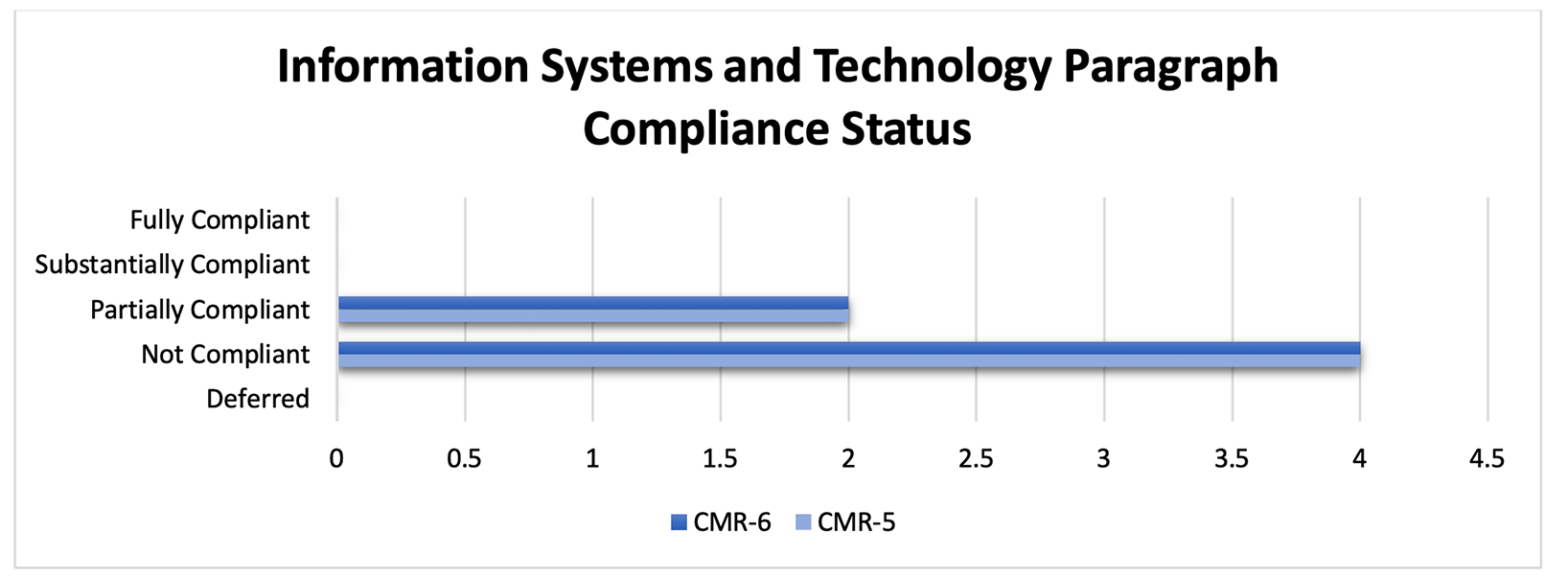
Conclusion and Looking Forward to CMR-7
In summary, as was the case in CMR-5, PRPB needs to do much additional work to develop and/or revise training and operationally implement the requirements in many areas of the Agreement. Although the renewed focus by the Court in the areas of IT, UOF, and Supervision and Management will hopefully generate some forward movement in compliance, PRPB’s progress continues to stall in many of the other areas of the Agreement despite repeated calls to action by the Monitor in his reports. Although the efforts needed to implement the reform are extensive, this remains an opportunity for the Bureau to improve upon its operations, bring its policies and training into the 21st century and in line with general policing practices, provide its officers with the facilities, equipment, and training they need, and more importantly, ensure the safety of both its officers and community. Adequate resources to carry out the reform in a sustainable manner and increased commitment are essential to PRPB moving its compliance with the Agreement forward.
Over the next six months, the Monitor looks forward to assessing PRPB’s progress on its implementation of the Provisional UOF Plan, collaborating with PRPB and USDOJ on the IT Needs Assessment, developing the IT Action Plan, and working with PRPB as it updates and implements its 2018 Staffing Plan to address its shortages of supervisors. The Monitor also stresses to PRPB to actively address or demonstrate actions taken to address the other issues raised in this report. Adequate resources and increased commitment and action to implement the reform is imperative to complying with the Agreement.
The Monitor will also continue to review documents produced by PRPB in demonstration of compliance, conduct additional field visits, observe related training sessions, observe PRPB’s community engagement efforts, and conduct interviews with both PRPB personnel and community stakeholders. Further, during the CMR-7 monitoring period, the Monitor hopes to conduct community listening sessions to share the status of reform and hear directly from the broader Puerto Rican Community.
The online version of this
Executive Summary for the
Report is provided for convenience only.
The document filed in The United States District Court for the District of Puerto Rico is the definitive version:
Case 3:12-cv-02039-FAB Document 2067-2 Filed 06/15/22